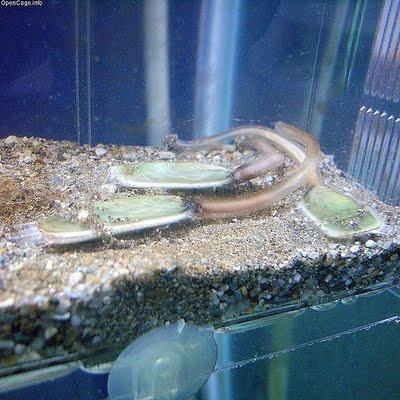| Linguliformea | ||
| Brachiopoda | Linguliformea |
| Metazoa | Metazoa | Metazoa | ||||
| Time |
|
Brachiopoda
├─Linguliformea
│ ├─Paterinida
│ └─Lingulata
│ ├─Lingulida
│ └─Acrotretida
│ ├─Discinida
│ └─Acrotretoidea
└─┬─Craniiformea
└─Rhynchonelliformea
|

Lingula anatina, from Open Cage.
Editor's note: Palaeos is a huge project, and hence updating it is beyond the scope of one person. For tis reason, and pending more original material, I have decided to cheat by copying (with minor editing, from Wikipedia MAK120107
In the revised classification of Brachiopods used in the current edition of the Treatise, Linguliformea is one of the three subphyla and major clades of brachiopods. Like the other two groups, they range from the Cambrian to Recent. These inarticulate brachiopods diversified and flourished during the Cambrian and Ordovician, but declined thereafter, with only a single order, the extant Lingulida, making it into the late Paleozoic.
Linguliforms have adductor and oblique muscles, but no diductor muscles. The anus is located at the side of the body. The pedicle is a hollow extension of the ventral body wall. Posterior body wall separates dorsal and ventral mantles. Their shells are usually made up of apatite (calcium phosphate), however rare cases have calcite or aragonite shells.
Characters (from Williams & Holmer 2002): Shell laminar, organophosphatic, attached by a pedicel developing as an outgrowth of the posterior body wall; gut U-shaped with both mouth and anus opening into mantle cavity.
There are two classes: Lingulata and Paterinata
Dendrogram
(only a few of the many genera and species are shown)
✶ Type species of genus indicated
Boxshall, G. A., & A. G. Humes. 1988. A new genus of Lichomolgidae (Copepoda: Poecilostomatoida) associated with a phoronid in Hong Kong. Bulletin of the British Museum (Natural History), Zoology Series 54 (6): 301-307. Braddy, S. J., P. A. Selden & D. N. Truong. 2002. A new carcinosomatid eurypterid from the Upper Silurian of northern Vietnam. Palaeontology 45 (5): 897-915.
Giribet, G., D. L. Distel, M. Polz, W. Sterrer & W. C. Wheeler. 2000. Triploblastic relationships with emphasis on the acoelomates and the position of Gnathostomulida, Cycliophora, Plathelminthes, and Chaetognatha: A combined approach of 18S rDNA sequences and morphology. Systematic Biology 49: 539-562.
Holmer, L. E., C. B. Skovsted & A. Williams. 2002. A stem group brachiopod from the Lower Cambrian: Support for a Micrina (halkieriid) ancestry. Palaeontology 45 (5): 875-882.
Kozlowski, R. 1948. Les graptolithes et quelques nouveaux groupes d'animaux du Tremadoc de la Pologne. Palaeontologica Polonica 3: I-XII, 1-235.
Prothero, D. R. 1998. Bringing Fossils to Life: An introduction to paleobiology. WCB McGraw-Hill: Boston.
Robson, S. P., G. S. Nowlan & B. R. Pratt. 2003. Middle to Upper Cambrian linguliformean brachiopods from the Deadwood Formation of subsurface Alberta and Saskatchewan, Canada. Journal of Paleontology 77 (2): 201-211.
Williams, A., & L. E. Holmer. 2002. Shell structure and inferred growth, functions and affinities of the sclerites of the problematic Micrina. Palaeontology 45 (5): 845-873.
Zhang, Z., J. Han, X. Zhang, J. Liu & D. Shu. 2004. Soft-tissue preservation in the Lower Cambrian linguloid brachiopod from South China. Acta Palaeontologica Polonica 49: 259-266.
page MAK120107 (Creative Commons Attribution license), characters, dendrogram and references CKT071117; intro text modified from Wikipedia